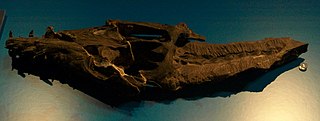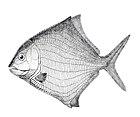
In the geologic timescale, the Olenekian is an age in the Early Triassic epoch; in chronostratigraphy, it is a stage in the Lower Triassic series. It spans the time between 251.2 Ma and 247.2 Ma. The Olenekian is sometimes divided into the Smithian and the Spathian subages or substages. The Olenekian follows the Induan and is followed by the Anisian.

The Induan is the first age of the Early Triassic epoch in the geologic timescale, or the lowest stage of the Lower Triassic series in chronostratigraphy. It spans the time between 251.9 Ma and 251.2 Ma. The Induan is sometimes divided into the Griesbachian and the Dienerian subages or substages. The Induan is preceded by the Changhsingian and is followed by the Olenekian.

Shonisaurus is a genus of very large ichthyosaurs. At least 37 incomplete fossil specimens of the type species, Shonisaurus popularis, have been found in the Luning Formation of Nevada, USA. This formation dates to the late Carnian-early Norian age of the Late Triassic, around 227 million years ago. Other possible species of Shonisaurus have been discovered from the middle Norian deposits of Canada and Alaska.

Birgeria is a genus of carnivorous marine ray-finned fish from the Triassic period. Birgeria had a global distribution, with fossil known from Madagascar, Spitsbergen, Germany, Switzerland, Italy, Slovenia, China, Russia, Canada and Nevada, United States. The oldest fossils are from Griesbachian aged beds of the Wordie Creek Formation of East Greenland. Birgeria existed throughout the entire Triassic period, from the very beginning just after the Permian-Triassic mass extinction, up to the very end with its extinction during the Triassic-Jurassic mass extinction.

Augustasaurus is an extinct genus of sauropterygians that lived during the Anisian stage of the Middle Triassic in what is now North America. Only one species is known, A. hagdorni, described in 1997 from fossils discovered in the Favret Formation, Nevada, USA.

Watsonulus is an extinct genus of prehistoric ray-finned fish that lived during the Early Triassic epoch in what is now Madagascar. It may have also existed in what is now Himachal Pradesh, India, during the Induan age. The type species, described by Jean Piveteau, is Watsonia eugnathoides. Because "Watsonia" was preoccupied, the new genus name Watsonulus was later erected. The genus is named after David Meredith Seares Watson.

Archaeolepidotus is an extinct genus of prehistoric marine holostean bony fish that lived during the latest Permian or earliest Triassic in what is now Trentino-Alto Adige, Italy. It contains a single species, A. leonardii. It is among the earliest known fossil neopterygians, and is usually recovered as a semionotiform, but others recover it as a parasemionotiform.

Pteronisculus is an extinct genus of prehistoric ray-finned fish that lived during the Early Triassic and Middle Triassic epochs of the Triassic period worldwide.
Eosaurichthys is an extinct genus of saurichthyid ray-finned fish that lived during the late Permian epoch in what is now China.
Caruichthys is an extinct genus of prehistoric freshwater ray-finned fish that lived during the Early Triassic epoch. It contains a single species, Caruichthys ornatus, known from what is now South Africa. It is known from a single specimen, which was collected from the middle Beaufort Series of Doorn River.

Mylacanthus is an extinct genus of prehistoric coelacanth lobe-finned fish that lived during the Smithian age of the Early Triassic epoch in what is now Svalbard.

Boreosomus is an extinct genus of Triassic marine ray-finned fish. It was first described from the Arctic island of Spitsbergen, hence its genus name, but was later also discovered in other parts of the world. The type species is Boreosomus arcticus.

Ptycholepiformes are an extinct order of prehistoric ray-finned fish that existed during the Triassic period and the Early Jurassic epoch. The order includes the genera Acrorhabdus, Ardoreosomus, Boreosomus, Chungkingichthys, Ptycholepis, and Yuchoulepis. Although several families have been proposed, some studies place all these genera in the same family, Ptycholepididae.
The Candelaria Formation is a geologic formation in Nevada, United States. The formation comprises shales and limestones deposited in an open marine environment and preserves fossils dating back to the Induan age of the Early Triassic epoch. Outcrops of the Candelaria Formation are present in the Candelaria Hills southeast of the now abandoned mining town of Candelaria, and near Willow Springs.
The Luning Formation is a geologic formation in Nevada. It preserves fossils dating back to the Triassic period. The lowermost strata dates to the late Carnian-early Norian boundary.

Palaeobates is an extinct genus of prehistoric elasmobranchs in the order Hybodontiformes. It lived during the Triassic period. It was a small shark about 1 m (3.3 ft) long. Palaeobates had a grinding-type dentition, which it used to crush hard-shelled prey. The teeth exhibit an orthodont histology.

Candelarialepis is an extinct genus of prehistoric marine ray-finned fish that lived during the Induan age of the Early Triassic epoch in what is now Nevada. It contains a single species, C. argentus. It was described from the Candelaria Formation.

Parasemionotiformes is an extinct order of neopterygian ray-finned fish that existed globally during the Triassic period. It comprises the families Parasemionotidae and Promecosominidae. Many of the included genera are monotypic and most species lived during the Early Triassic epoch.
Turseodus is an extinct genus of ray-finned fish found in Late Triassic freshwater sediments of the United States. Two species have been described, T. acutus from the Lockatong Formation of Pennsylvania, and T. dolorensis from the Chinle Formation of Colorado.
The Paris biota is an exceptionally diverse Early Triassic fossil assemblage described in 2017 from the Lower Shale Member of the Thaynes Group. It was first discovered in Paris Canyon, west of the town of Paris in Bear Lake County, southeastern Idaho, United States. This biota was later also found in coeval and slightly younger beds in northeastern Nevada and Bear Lake and Caribou counties, southeastern Idaho.






















